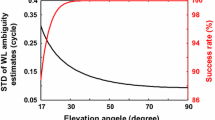Abstract
In this contribution the integer least-squares estimation of the double differencedL 1 andL 2 ambiguities is analyzed, under the provision that the relative receiver-satellite geometry is dispensed with. The variance-covariance matrix of the ambiguities is instrumental for gaining insight into the characteristics of the ambiguity fixing process. A qualitative geometric description in detail is therefore given of the ambiguity search space. The elongation, the correlation coefficient and the areas of the ambiguity search space and its enclosing boxes are all given as function of the ratio or product of the carrier phase and code standard deviations. It is shown that the ambiguity search space is very elongated and that the ambiguities are highly correlated. It is also shown how the high correlation between the ambiguities can be used to ones advantage for the transformation to new ambiguities. This is done by means of the least-squares ambiguity decorrelation adjustment method. The improvements in terms of decorrelation, elongation and precision are shown and the corresponding optimal time-invariant ambiguity transformations are given for a practical range of code and measurement precisions.
Similar content being viewed by others
References
Blewitt, G. (1989): Carrier phase ambiguity resolution for the Global Positioning System applied to geodetic baselines up to 2000 km.Journal of Geophysical Research, Vol. 94, No. B8, pp. 10.187–10.203.
Dedes, G., C. Goad (1994): Real-Time cm-level GPS Positioning of Cutting Blade and Earth Moving Equipment.Proceedings of the 1994 National Technical Meeting ION, San Diego, California, pp. 587–594.
Euler, H.-J., C. Goad (1990): On Optimal Filtering of GPS Dual Frequency Observations without using Orbit Information.Bulletin Geodesique, Vol. 65, pp. 130–143.
Euler, H.-J., H. Landau (1992): Fast GPS Ambiguity Resolution On-The-Fly for Real-Time Applications. Proceedings6th Int. Geod. Symp. on Satellite Positioning. Columbus, Ohio, 17–20 March 1992, pp. 650–729.
Euler, H.-J., R. Hatch (1994): Comparison of Several AROF Kinematic Techniques.Proceedings ION-94. pp. 363–370.
Frei, E., G. Beutler (1990): Rapid Static Positioning Based on the Fast Ambiguity Resolution Approach FARA: Theory and First Results.Manuscripta Geodaetica, Vol. 15, No. 6, 1990.
Hatch, R. (1982): The Synergism of GPS Code and Carrier Measurements.Proceedings 3th International Geod. Symp. on Satellite Positioning, Las Cruces, New Mexico, 8–12 February, 1982, Vol. 2, pp. 1213– 1231.
Hatch, R. (1986): Dynamic Differential GPS at the Centimeter Level.Proceedings 4th International Geod. Symp. on Satellite Positioning, Austin, Texas, 28 April – 2 May 1986, pp. 1287–1298.
Hatch, R. (1991): Instantaneous Ambiguity Resolution. Proceedings of the IAGInternational Symposium 107 on Kinematic Systems in Geodesy, Surveying and Remote Sensing, Sept. 10–13, 1990, Springer-Verlag, New York, pp. 299–308.
Teunissen, P.J.G. (1993):Least-Squares Estimation of the Integer GPS Ambiguities. Invited Lecture, Section IV Theory and Methodology, IAG General Meeting, Beijing, China, August 1993. Also in LGR-Series No. 6, 16 p.
Teunissen, P.J.G. (1994a): A New Method for Fast Carrier Phase Ambiguity Estimation.Proceedings IEEE Position Location and Navigation Symposium PLANS'94, pp. 562–573.
Teunissen, P.J.G. (1994b): On the GPS double-differenced ambiguities and their partial search spaces. Proceedings Hotine-Marussi Symposium on Mathematical Geodesy, L'Aquila, Italy May 29–June 3, 1994,Geodetic Theory Today, Symposium No. 114, IAG, pp. 39–48.
Teunissen, P.J.G., P.J. de Jonge and C.C.J.M. Tiberius (1994): On the Spectrum of the GPS DD-Ambiguities.Proceedings ION GPS-94, Salt Lake City, Utah, USA, September 20–23, 1994, pp. 115–124.
Teunissen, P.J.G., P.J. de Jonge and C.C.J.M. Tiberius (1995): A new way to fix carrier-phase ambiguities. In:GPS-World. April 1995, pp. 58–61.
Teunissen, P.J.G. (1995a): The invertible GPS ambiguity transformations,Manuscripta Geodaetica, September 1995, Vol. 20, No. 6, pp. 489–497.
Teunissen, P.J.G. (1995b): GPS Carrier Phase Ambiguity Fixing Concepts. In:Lecture Notes in Earth Sciences “International School GPS for Geodesy”, Chapter 8, 8.1–8.75. To be published by Springer Verlag.
Tiberius, C.C.J.M., P.J. de Jonge (1995a): Fast Positioning using the LAMBDA-Method. In:Proceedings DSNS95, April 24–28, Bergen, Norway.
Tiberius, C.C.J.M., P.J. de Jonge (1995b): Introduction to GPS Surveying (Part 4). In:Geomatics Info Magazine, October 1995, pp. 61–67.
Wübbena, G. (1991):Zur Modellerung von GPS Beobachtungen für die Hochgenaue Positions-bestimmung. Universität Hannover, Germany.
Author information
Authors and Affiliations
Rights and permissions
About this article
Cite this article
Teunissen, P.J.G. An analytical study of ambiguity decorrelation using dual frequency code and carrier phase. Journal of Geodesy 70, 515–528 (1996). https://doi.org/10.1007/BF00863624
Received:
Accepted:
Issue Date:
DOI: https://doi.org/10.1007/BF00863624




